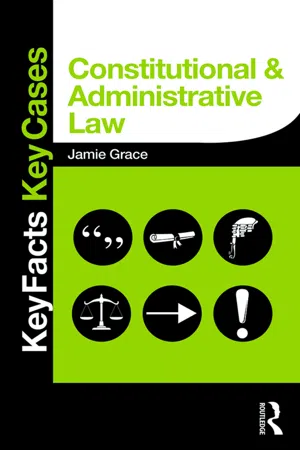
Constitutional and Administrative Law
Key Facts and Key Cases
Jamie Grace
- 290 pages
- English
- ePUB (mobile friendly)
- Available on iOS & Android
Constitutional and Administrative Law
Key Facts and Key Cases
Jamie Grace
About This Book
Key Facts Key Cases Constitutional & Administrative Law will ensure you grasp the main concepts of your Constitutional & Administrative Law module with ease. This book explains the facts and associated case law for:
- The European Court of Human Rights and the UK Supreme Court
- Devolution
- Human rights law
- EU membership
- International law in the UK Constitution
Key Facts Key Cases is the essential series for anyone studying law at LLB, postgraduate and conversion courses. The series provides the simplest and most effective way to absorb and retain all of the material essential for passing your exams. Each chapter includes:
-
- diagrams at the start of chapters to summarise key points
-
- structured headings and numbered points to allow for clear recall of the essential points
-
- charts and tables to break down more complex information
Chapters are also supported by a Key Cases section which provides the simplest and most effective way to absorb and memorise essential cases needed for exam success.
-
- Essential and leading cases are explained
-
- The style, layout and explanations are user friendly
-
- Cases are broken down into key components by use of a clear system of symbols for quick and easy visual recognition
Frequently asked questions
The development of constitutional and administrative law in the UK
1
Contemporary and foundational issues in public law

1.1 What is a constitution?
- • establish the organs of government. Traditionally, this would consist of a body responsible for legislative functions; a body responsible for executive functions; and a body responsible for judicial functions;
- • allocate power between those institutions;
- • provide for the resolution of disputes on the interpretation of the constitution; and
- • establish procedures etc. for the amendment of the constitution.
1.2 Classifying constitutions
- • revolution (e.g. France 1789);
- • reconstruction and/or redefinition of a State’s institutions following war/armed conflict (e.g. Germany, Iraq);
- • conferment of independence on a former colony (e.g. India, Australia, Canada);
- • creation of a new State by the union of formerly independent States (e.g. United States, Malaysia);
- • creation of a new State(s) by the break-up of a former Union of States (e.g. States created by the break-up of the former Republic of Yugoslavia).
- • the 1688 Revolution;
- • the Union of England and Scotland (1707) and Great Britain with Ireland (1800);
- • the House of Lords crisis 1910;
- • the abdication of the Monarch 1936; and
- • joining the European Economic Community (now known as the European Union) in 1973.
- • Bill of Rights 1688/9;
- • Parliament Act 1911;
- • Abdication Act 1936; and
- • European Communities Act 1972.
- • A flexible constitution is one where all the laws of that constitution may be amended by the ordinary law-making process. The United Kingdom has a flexible constitution.
- • A rigid constitution is one where the laws of that constitution can only be amended by special procedures. Consequently, the constitution is ‘entrenched’. In other words, it is protected from being changed by the need to comply with a special procedure.
- • a two-thirds majority in each House of the Federal Congress (the legislative body), followed by:
- • the acceptance (ratification) of at least three-quarters of the individual states that make up the United States.
- • federal constitution is one where government powers are divided between central (federal) organs and the organs of the individual states/provinces that make up the federation. For example, the United States and Canada have federal constitutions. If there is to be any change in the distribution of power between the federal organs and the state organs, there must be amendment of the constitution using a special procedure.
- • A unitary constitution is one where all government power rests in the hands of one central set of organs.
- • Supreme or subordinate – if the legislature cannot change the constitution by itself, then the constitution is supreme. If the legislature can change the constitution by itself, then it is subordinate.
- • Monarchical or republican:
- (a) In a monarchical constitution, the Head of State is a King or Queen and State powers are exercised in ...
Table of contents
- Cover
- Title
- Copyright
- Contents
- PREFACE
- TABLE OF CASES
- TABLE OF STATUTES
- PART 1 THE DEVELOPMENT OF CONSTITUTIONAL AND ADMINISTRATIVE LAW IN THE UK
- PART 2 PUBLIC LAW IN PRACTICE
- INDEX